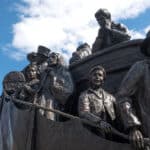Learn about the history of the Irish Memorial to the stories of Ireland and its peoples. For 8 centuries the people of Ireland were governed by a foreign power and subjected to institutionalized oppression. They were forbidden by law to speak their native language, practice their religion, gain an education, own property, or hold any position of consequence in either the military or the law. The mid-sixteenth and seventeenth centuries saw the greatest confiscation of the most fertile Irish land located in the eastern part of the country. By 1691 approximately eighty percent of the land had been taken, forcing many of the people to flee westward where the poorest farmland was located.
Potatoes, one of the few crops that could be grown there, were rich in potassium, carbohydrates and vitamins. For this reason and because virtually no other food was available to them, potatoes became the chief source of nutrition for millions of people. Thus, the stage was set for catastrophe when this source was lost. The Great Hunger (An Gorta Mór) in Ireland triggered by the failure of the potato crops 1845/1850 led to the single greatest loss of life in Europe between the Napoleonic Wars and World War I. It was a human tragedy of appalling dimensions. The real tragedy is that the so-called “Irish Potato Famine” never should have occurred. Remember, only one crop failed. There was no “famine.”
While more than a million Irish either starved or died from starvation-related illness and another million were forced to emigrate, food was being forcibly exported from the country by its foreign rulers – food sufficient to feed the people several times over. This period represented the blackest days of Irish history.
The years 1995-2000 represent the Sesquicentennial of this tragedy. Those who did manage to survive the arduous journey, found less than a welcome on these shores. In the words of Peter Quinn: “The Irish were swiftly identified in the popular mind with poverty, disease, alcohol abuse, crime and violence – all the enduring pathologies of the urban poor. Indeed, the level of social turmoil that followed the Irish into America’s cities would not be seen again for another century.”
In his book; The Irish In Philadelphia, Dennis Clark, Ph.D. described how Irish immigrants helped foster the growth of our city, state and country. From entry level jobs such as digging canals, mining coal, building the railroads, they have made significant contributions in fields of Business, Education, Government, Industry, Medicine, Religion, Science and many more.






